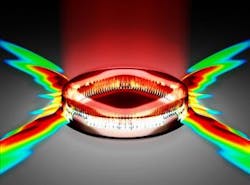| Shaping the area to which energy is delivered within a laser could greatly improve the laser's performance by reducing spatial hole burnig. Here, energy is pumped into a diamond shape. (Illustration by Omer Malik, Princeton University) |
Engineers at Princeton University (Princeton, NJ) have shown that carefully restricting the delivery of pump energy to selected areas within a laser, which allows certain higher-order modes to operate instead of the usual lower-order modes, could boost output by many orders of magnitude.1 The approach, in which the pump profile is spatially tailored, limits the effects of nonlinear wave interactions such as spatial hole burning, thus boosting efficiency.
The results, based on mathematical calculations and computer simulations, still need to be verified in experiments with actual lasers, but the researchers said it represents a new understanding of the fundamental processes that govern how lasers produce light.
"It's as though you are using loss to your advantage," says graduate student Omer Malik, an author of the study along with Li Ge, now an assistant professor at the City University of New York, and Hakan Tureci, assistant professor of electrical engineering at Princeton.
The researchers say that restricting the delivery of power causes much of the physical space within a laser to absorb rather than produce light. In exchange, however, the optimally efficient portion of the laser is freed from competition with less efficient portions and lases far more brightly than previous estimates had suggested.
"Distributing gain and loss within the material is a higher level of design -- a new tool -- that had not been used very systematically until now," Tureci says.
In one example, a laser with a disk-shaped resonator, might normally reach threshold first only within a ring close to the disk's edge (a whispering-gallery mode). As more energy is added, more modes emerge that exist closer to the center of the disk; these modes begin to interact and sap energy from each other.
Because of this competition, subsequent modes requiring higher energy may never reach their lasing thresholds. However, Tureci's research group found that some of these higher threshold modes were potentially far more efficient than the earlier ones if they could just be allowed to function without competition.
The researchers showed this selection could be accomplished by directing current only to the physical location where the desired mode originates. In particular, they showed how to calculate exactly how beneficial such targeting would be; the answer was much more than expected.
Considering the full range of modes
Previous studies had looked at applying electric current only to the part of the laser that first reaches threshold, which succeeded in lowering the overall amount of power required to get that the laser to turn on. However, these studies did not consider the full range of modes, nor provide a way to calculate how brightness and efficiency could be controlled by targeting the delivery of current.
Instead of looking at just the first modes, Tureci's team examined dozens of possible modes and found ones that were optimally efficient. In one simulation, the most effective mode was preceded by 29 other less-efficient modes that could turn on first and monopolize the pump energy. The researchers showed that applying electric current only to the pattern associated with this mode would cause it to light up first, free of competition. Targeting these higher order modes produced improvements of efficiency ranging from 100-fold to 10,000-fold, depending on the size, shape, and material of the cavity.
Once a laser is built with the fine-grained electrical connections that allow this targeting, then its performance can be controlled "on the fly," says Tureci, "not just during fabrication."
Just how fine the targeting needs to be depends on the wavelength of light being produced. For typical lasers described in the study, the power would need to be delivered to a space at resolutions on the scale or micrometers.
Source: http://www.princeton.edu/engineering/news/archive/?id=13791
REFERENCE:
1. Li Ge et al., Nature Photonics (2014); doi: 10.1038/nphoton.2014.244
